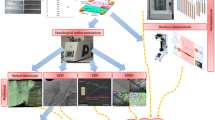Abstract
In order to assess the new tribological properties of laser surface hardened GCr15 steel, the wear resistance between specimens treated with laser and those of conventionally hardened under dry sliding conditions was compared. The change of wear mechanisms in laser hardened GCr15 resulted in a distinct difference in wear rates. The results showed that quenched zones not only had sufficient depth of hardening and higher hardness, but had more retained austenite and finer carbides because of a higher degree of carbide dissolution. Laser surface hardened GCr15 steel specimens exhibited superior wear resistance to their conventionally hardened specimens due to the effects of the microstructure hardening, high hardness and toughness. The wear mechanism for both the laser quenched layer and conventionally hardened layer was highly similar, generally involving adhesive, material transfer, wear-induced oxidation and plowing. When conventionally hardened block specimens rubbed against the laser hardened specimens, the surface of conventionally hardened block specimens was polished. The microstructural thermal stability was increased after laser surface treatment.
Similar content being viewed by others
References
S R Yu, Y Liu, L Q Ren, et al. Development of Laser-Cladding Layers Containing Nano-Al2O3 Particles for Wear-Resistance Materials[J]. Metallurgical and Material Transactions, 2006 (37A): 3 639–3 645
R Komanduri Z. Thermal Analysis of the Laser Surface Transformation Hardening Process[J]. International Journal of Heat and Mass Transfer, 2001 (44): 2 845–2 862
Q B Liu. Experimental Study of the Laser Quenching of 40CrNiMoA Steel[J]. Journal of Materials Processing Technology, 1999 (88): 77–82
T Reti. Prediction of as-quenched Hardness After Rapid Austenitization and Cooling of Surface Hardened Steels[J]. Computational Materials Science, 1999 (44): 111–112
K H Loa. Effects of Laser Treatments on Cavitation Erosion and Corrosion of AISI 440C Martensitic Stainless Steel[J]. Materials Letters, 2003 (58): 88–93
T Miokovic, V Schulze. Influence of Cyclic Temperature Changes on the Microstructure of AISI 4140 after Laser Surface Hardening[J]. Acta Materialia, 2007 (55): 589–599
R Kaul. Characterization of Dry Sliding Wear Resistance of Laser Surface Hardened En 8 Steel[J]. Journal of Materials Processing Technology, 2005 (167): 83–90
F C Zhang. A Study of Friction-induced Martensitic Transformation for Austenitic Manganese Steel[J]. Wear, 1997 (76): 195–198
R Komanduri. Influence of the Processing Conditions on the Abrasive Wear Behaviour of a Laser Surface Melted Tool Steel[J]. Scripta Materialia, 1999 (44): 715–721
Y Q Xia. Comparative Study of the Tribological Properties of Various Modified Mild Steels under Boundary Lubrication Conditions[J]. Tribology International, 2005 (38): 508–514
Author information
Authors and Affiliations
Corresponding author
Additional information
Funded By the Natural Science Research Foundation of Department of Education of AnHui Province in China( No.KJ2009A021)
Rights and permissions
About this article
Cite this article
Lei, S., Liu, Q., Ma, Y. et al. Wear performance of laser surface hardened GCr15 steel. J. Wuhan Univ. Technol.-Mat. Sci. Edit. 25, 84–88 (2010). https://doi.org/10.1007/s11595-010-1084-x
Received:
Accepted:
Published:
Issue Date:
DOI: https://doi.org/10.1007/s11595-010-1084-x




